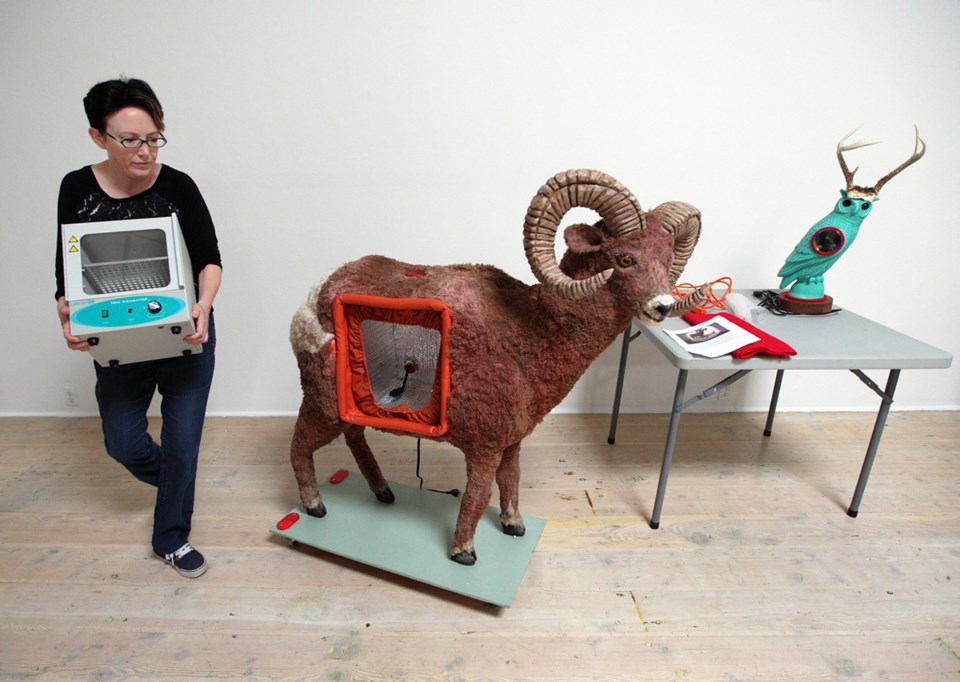What: Natural Science
When: Continues to July 30
Where: Open Space gallery, 510 Fort St.
Admission: By donation
There’s a horned sheep sculpture with a lab incubator inside it. There’s a bear-skin rug with a model of a human spine attached to its back.
And there’s the Algae Organ, a working organ equipped with an algae incubator, soon to be bicycled around the streets of Victoria. It’s all part of Natural Science, a new exhibition at Open Space gallery.
Jennifer Willet, a visual arts professor at the University of Windsor, is the artist responsible for these whimsical creations. Willet specializes in bioart, art that incorporates living organisms, such as bacteria.
A cross between art and science, bioart has come to the fore over the past 20 years. The term “bioart” was coined by American artist Eduardo Kac, who used it to describe his 1997 art project Time Capsule, for which a microchip was implanted in his ankle.
Willet’s not implanting herself with anything for Natural Science. However, she — like Kac — is fascinated by the intersection of art and science.
Her Open Space installation is an artistic response to a previous project, BioArtCamp. In 2011, she invited 20 artists, scientists and students to camp in the forests of Banff. There, they undertook a variety of biology and art projects using a portable bioart laboratory. Willet observed the whole thing, taking an overview.
“My own project was to assess the entire camp, as maybe a natural scientist would, 100 years ago or something like that,” she said.
Objects such as the sheep sculpture (it’s properly called An Incubator in Sheep’s Clothing) come directly from BioArtCamp. The moth-eaten-looking sheep has a square opening in its stomach to hold a functional incubator. There’s a petri dish inside, containing dried bacterial culture, the remains of one of the BioArtCamp experiments.
The bear rug, another BioArtCamp relic, was donated to Willet by an Ontario hunter who shot the cub from which it’s made. The hunter was willing to part with it, she recalled.
“He was getting married and his fiancée said: ‘It’s me or the bear.’ ”
The human-spine model on the bear rug’s back is in a clear plastic case. Also under the case: a petri dish with more dried-up bacteria. It makes for a strange artifact, and that’s intentional, Willet said.
One of Natural Science’s themes is its indirect nod to humankind’s historically “colonialist” attitude in the way we organize life forms into different categories. Another of its aims is to point out the artificiality of separating science and the so-called natural world.
“The organisms we see in the lab are as much of the Earth’s ecology as the organisms we see in the forest,” Willet said.
Elsewhere at Open Space, where the artist was setting up this week, were shadow boxes containing old postcards and test tubes. There was an antlered “owl nightlight” (the eyes and incubator light up). There were also sculptures of red crows, a green duck with wheels and a teal fawn.
The pièce de résistance, waiting to be assembled, was Algae Organ. Featuring wood carvings, statues of fawns and clear tubing, the wheeled object was inspired by street organs Willet saw in Amsterdam. This one is outfitted with a custom-made, hand-cranked organ that plays music using perforated paper sheets.
Algae Organ is attached to a bicycle-like device, enabling Willet to pull it around Victoria.
“We’ll probably parade it in the street a number of times over the next two weeks,” she said.
As well as playing music, Algae Organ will incubate spirulina algae, some of which will be squirted through the organ’s clear tubes. Willet spent three months growing algae in her basement in preparation for the Victoria show.
Today, from 2 p.m. to 5 p.m., the artist will give a talk at Open Space and demonstrate the Algae Organ. This will be followed by a hands-on workshop in which the public is invited to participate in the process of growing one’s own algae.
On Wednesday at Open Space, from 5 to 8 p.m., Willet will conduct a yeast workshop. The public can learn about biological art practices, collect yeast samples and make potato dextrose agar plates (petri dishes with growth media).
Samples from the workshop will be displayed at DIY Life: Art + Science + Ecology Fair from noon to 5 p.m. on June 25. Taking place at Fisherman’s Wharf Park, the fair gathers people who will display their art, science and ecology projects. Locals, such as “people who are making their own cheese,” will be invited.
Willet is aware that, for someone who views art as canvases in frames, the world of bioart can seem a touch bewildering.
“A lot of articles that get written about my work, the first sentence is: ‘But is it art?’ ” she said. “A lot of the work I do also looks like science … my practice is really hybrid.”
